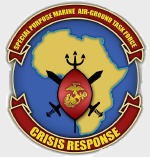Forces of Valor FOVOsprey USMC Bell-Boeing MV-22 Osprey Tiltrotor Aircraft [Low-Vis Scheme] (1:72 Scale)
"Its [The V-22's] production costs are considerably greater than for helicopters with equivalent capability -- specifically, about twice as great as for the CH-53E, which has a greater payload and an ability to carry heavy equipment the V-22 cannot... an Osprey unit would cost around $60 million to produce, and $35 million for the helicopter equivalent."
- Michael E. O'Hanlon, senior fellow at The Brookings Institution, 2002
 The Bell Boeing V-22 Osprey is an American multi-mission, military, tiltrotor aircraft with both a vertical takeoff and landing (VTOL), and short takeoff and landing (STOL) capability. It is designed to combine the functionality of a conventional helicopter with the long-range, high-speed cruise performance of a turboprop aircraft.
The Bell Boeing V-22 Osprey is an American multi-mission, military, tiltrotor aircraft with both a vertical takeoff and landing (VTOL), and short takeoff and landing (STOL) capability. It is designed to combine the functionality of a conventional helicopter with the long-range, high-speed cruise performance of a turboprop aircraft.
The V-22 originated from the United States Department of Defense Joint-service Vertical take-off/landing Experimental (JVX) aircraft program started in 1981. The team of Bell Helicopter and Boeing Helicopters was awarded a development contract in 1983 for the tiltrotor aircraft. The Bell Boeing team jointly produce the aircraft. The V-22 first flew in 1989, and began flight testing and design alterations; the complexity and difficulties of being the first tiltrotor intended for military service in the world led to many years of development.
The United States Marine Corps began crew training for the Osprey in 2000, and fielded it in 2007; it is supplementing and will eventually replace their CH-46 Sea Knights. The Osprey's other operator, the U.S. Air Force, fielded their version of the tiltrotor in 2009. Since entering service with the U.S. Marine Corps and Air Force, the Osprey has been deployed in both combat and rescue operations over Iraq, Afghanistan and Libya.
Pictured here is a gorgeous 1:72 scale diecast replica of a USMC Bell-Boeing MV-22 Osprey tiltrotor aircraft.
Pre-order! Price and ship date to be determined.
Dimensions:
Wingspan: 7-inches
Length: 8-inches
Release Date: ?
 Historical Account: "Special Purpose Marine Air-Ground Task Force for Crisis Response" - The Special Purpose Marine Air-Ground Task Force Crisis Response is a Marine Air-Ground Task Force that is currently postured at Morn Air Base in Spain. SP-MAGTF Crisis Response reports to U.S. Marine Corps Forces Africa under United States Africa Command. It is a self-mobile, self-sustaining force of approximately 500 Marines and sailors, capable of responding to a range of crises. The unit is specifically trained to support U.S. and partner interests throughout the United States Africa Command area of responsibility, to include embassy reinforcement, support to noncombatant evacuation operations, tactical recovery of aircraft and personnel, humanitarian assistance, and disaster relief. The unit also takes part in bilateral and multilateral training exercises with regional partners. It is commanded by a Marine colonel.
Historical Account: "Special Purpose Marine Air-Ground Task Force for Crisis Response" - The Special Purpose Marine Air-Ground Task Force Crisis Response is a Marine Air-Ground Task Force that is currently postured at Morn Air Base in Spain. SP-MAGTF Crisis Response reports to U.S. Marine Corps Forces Africa under United States Africa Command. It is a self-mobile, self-sustaining force of approximately 500 Marines and sailors, capable of responding to a range of crises. The unit is specifically trained to support U.S. and partner interests throughout the United States Africa Command area of responsibility, to include embassy reinforcement, support to noncombatant evacuation operations, tactical recovery of aircraft and personnel, humanitarian assistance, and disaster relief. The unit also takes part in bilateral and multilateral training exercises with regional partners. It is commanded by a Marine colonel.
In 2013, following the 2012 Benghazi attack, Lt. Gen. Richard Tryon, Marine Corps deputy commandant for plans, policies and operations, announced the creation of a Special Purpose Marine Air Ground Task Force that could fly in a company of Marines on MV-22 Ospreys to respond to crises in Africa. However, this will require political work to secure a ground base nearby that the amphibious ships operating in the global commons of the world's oceans do not require. The task force self-deployed to Morn Air Base on April 27th, 2013.
USMC spokesman Capt. Eric Flanagan has listed the responsibilities of the task force to be a first responder for American embassies in the area, to help evacuate Americans, and to provide humanitarian and disaster relief.
Throughout 2013, SP-MAGTF Crisis Response joined with regional military and civilian partners to establish positive relationships. In June, elements of the unit went to Italy during the 100th anniversary of Italian naval aviation where they showcased the U.S. Marine Corps' MV-22B Osprey. In August, SP-MAGTF Crisis Response's ground combat element, then comprised mostly from Marines with 2nd Reconnaissance Battalion took part in two separate bilateral training exercises with the Spanish Brigada de Infantera Ligera Paracaidista. The first was a live-fire event near Uceda and the second was a free-fall parachute exercise over Naval Station Rota Spain. In October the unit moved to Camp des Garrigues to train with the 2nd Foreign Infantry Regiment.
In January 2014, the SPMAGTGF-CR operated out of Entebbe, Uganda to evacuate American staff in response to the South Sudan conflict.


